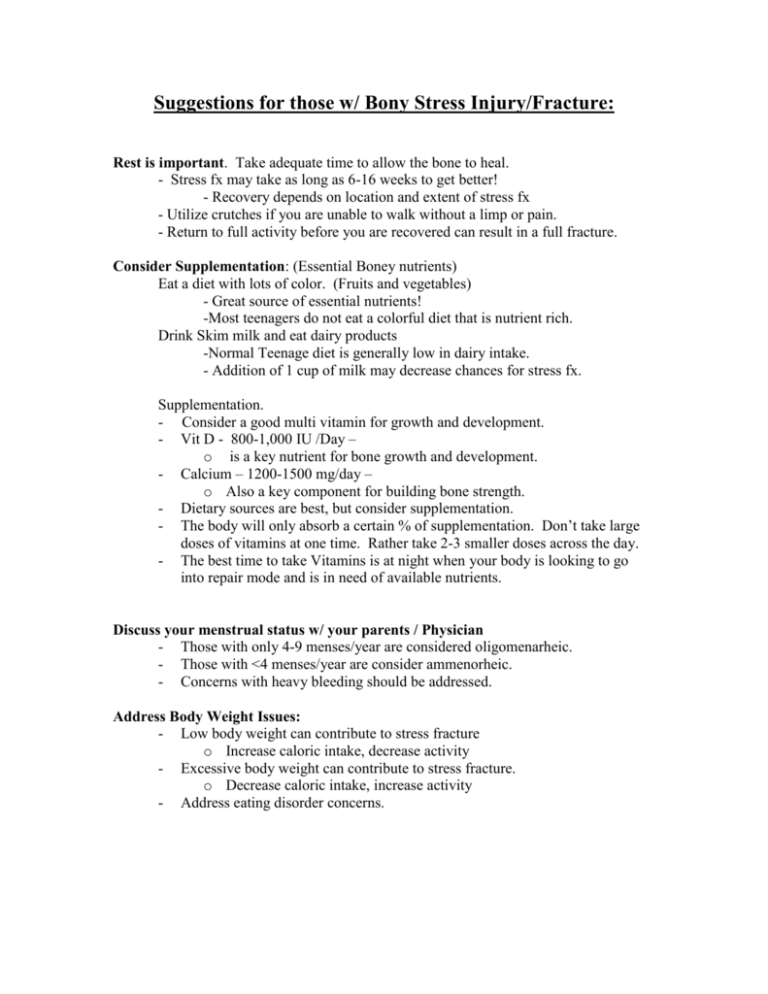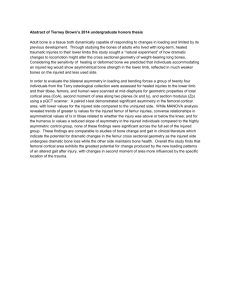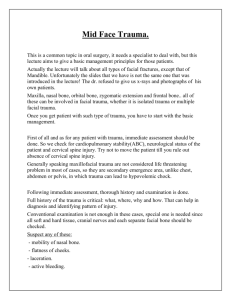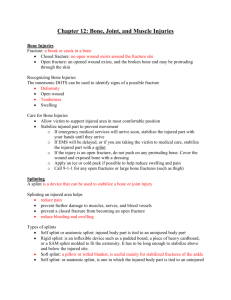Suggestions for those with Bony Stress Injury/Fracture
advertisement

Suggestions for those w/ Bony Stress Injury/Fracture: Rest is important. Take adequate time to allow the bone to heal. - Stress fx may take as long as 6-16 weeks to get better! - Recovery depends on location and extent of stress fx - Utilize crutches if you are unable to walk without a limp or pain. - Return to full activity before you are recovered can result in a full fracture. Consider Supplementation: (Essential Boney nutrients) Eat a diet with lots of color. (Fruits and vegetables) - Great source of essential nutrients! -Most teenagers do not eat a colorful diet that is nutrient rich. Drink Skim milk and eat dairy products -Normal Teenage diet is generally low in dairy intake. - Addition of 1 cup of milk may decrease chances for stress fx. Supplementation. - Consider a good multi vitamin for growth and development. - Vit D - 800-1,000 IU /Day – o is a key nutrient for bone growth and development. - Calcium – 1200-1500 mg/day – o Also a key component for building bone strength. - Dietary sources are best, but consider supplementation. - The body will only absorb a certain % of supplementation. Don’t take large doses of vitamins at one time. Rather take 2-3 smaller doses across the day. - The best time to take Vitamins is at night when your body is looking to go into repair mode and is in need of available nutrients. Discuss your menstrual status w/ your parents / Physician - Those with only 4-9 menses/year are considered oligomenarheic. - Those with <4 menses/year are consider ammenorheic. - Concerns with heavy bleeding should be addressed. Address Body Weight Issues: - Low body weight can contribute to stress fracture o Increase caloric intake, decrease activity - Excessive body weight can contribute to stress fracture. o Decrease caloric intake, increase activity - Address eating disorder concerns. Creams/Ointments: Creams and ointments act as skin irritants. They DO NOT increase the blood flow to the bone or deeper muscles. Biofreeze does not have a freezing effect on the tissue. Icy Hot does not increase the blood flow to the bone or deeper tissue. They merely cause a skin irritation, stimulate the sensory nerves which may decrease some of the pain sensation, but they WILL NOT provide any physiologic benefit or speed healing. Special Sleeves/Wraps – Physiologically, a cloth or neoprene sleeve WILL NOT provide appreciable support to your bone or leg. Don’t overlook the value of good injury care. Ice and elevation can be beneficial in helping to reduce swelling and the pain associated with a bony stress injury. Exercise Exercise that does not stress your fracture site is encouraged as increased circulation is essential for optimal bone healing. Biking, pool work, elliptical, or Ultra G are encouraged as they will increase blood flow and facilitate healing. Pain is your best guide. If it hurts or increases your pain, don’t do it. Strengthening Exercises: There really isn’t any way to do strengthening work for your bone when you are trying to recover from a bony stress injury. Weight training has been noted to be beneficial for increasing bone strength in the active population, but when injured, strength exercises that stress your recovering injury are contra-indicated. Stretching Exercises: Stretching exercises are contra- indicated during the initial phase of recovery. Light stretching may be incorporated during the return to sporting phase of recovery. Weight training activity is encouraged for all athletes as part of a general fitness program. Avoid any lifting with your injured extremity. Modify all activity to accommodate your disability. If your lower body is injured, work your upper body. If your right leg is injured, work your left leg. Just because your injured doesn’t mean you need to stop weight training. If you have questions about a specific weight training exercise and how it may affect your injury, please discuss it with the athletic trainer. Correct Faulty Biomechanics Faulty biomechanics should be addressed by a well- trained Athletic Trainer or Physical Therapist. Consider Orthodics Individuals who have been identified with faulty biomechanics may benefit from The use of an orthodic to help dissipate forces and correct faulty mechanics. - An orthotic will help to support your foot in a “neutral” position. - Custom Orthotics can be made by a podiatrist, athletic trainer or physical therapist or they can be “custom” made by using and impression tray. They can be something as simple as an arch support that you get at Dick’s or your local drugstore, or as complex as a custom made one with special postings and accommodations. Generally, arch supports that you get in a drug store are only 20-30% effective, but they may work for some people. Those with greater biomechanical issues may consider a more controlling orthotic. - Consider trying an inexpensive orthotic that is “custom made” by Foot Management, Inc. The orthotics cost $90-100 and are effective for 50-60% of users. www.footmanagement.com Shoes: Just because a shoe says Nike, looks great or you paid a lot of money for them, doesn’t make them the right shoe for your foot. Shoes should be fit for your foot posture. High arched people need more flexible shoes, flat footed/over pronators need shoes with more arch and heel support. If you can bend a shoe in half or rock the heel easily, it’s a flexible shoe. If it is more solid, it has more support. If you have been wearing your shoes for mver then 300 miles, they probably have lost 50% of their shock absorbing ability. You might consider getting new shoes!








![RAD_cat1[1]](http://s3.studylib.net/store/data/006806531_1-3c70d7d19a34870c74a6c0078adc7c88-300x300.png)


